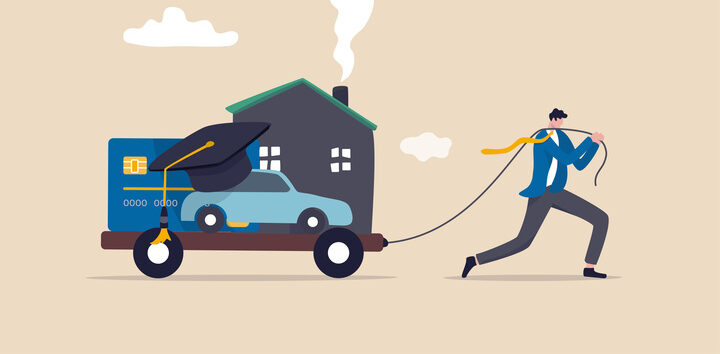Written by: Kristen Jowers, M.S. and Nichole Huff, Ph.D, CFLE
With rising inflation, convenience spending, and an increase in credit card use, American consumer debt hit $17.5 trillion in the fourth quarter of 2023 according to The Federal Reserve Bank of New York. Debt accrual has become a necessity for many families to purchase a home, go to college, and make major purchases, like appliances and vehicles.
When a reasonable debt repayment plan fits within a service members’ budget/spending plan, it can be a tool to build capital (e.g., mortgage, student loans). However, problems arise when spending outpaces earning and a cycle of debt intensifies. Take, for example, high-interest consumer debt like credit cards. Making the $60 minimum payments on a $2,000 credit card balance with 20% APR interest results in paying more than $4,100 over thirteen years. However, the average credit card interest rate in March 2024 is 24.37%. The same $2,000 credit card balance and $60 minimum payment would result in paying more than $5,300 over sixteen years.
According to J.D. Power, the percentage of Americans with a revolving credit card balance increased to 51% in 2023. Below are fast facts regarding common consumer debt including auto loans, mortgages, and student loans.
Auto loans
- Auto debt hit $1.601 trillion in the fourth quarter of 2023 in the New York Federal Reserve Bank’s Quarterly Report on Household Consumer Debt and Credit. At the same time, the average new car payment was $739 and the average auto loan interest rate for new cars was 7.4%. In the fourth quarter of 2023, 17.9% of car buyers committed to making $1,000 car payments. The number of new car buyers committing to a $1,000 car note has tripled between 2019 and 2023.
Mortgages
- The total outstanding mortgage debt balance in America is $11.58 trillion at the end of 2023. The average individual mortgage balance was $244,498 in 2023, an $8,000 increase from 2022. Gen Z (ages 18-26) had the highest percentage increase in mortgage balance between 2022-2023. However, Millennials still carried the highest average mortgage debt balances in 2023. View the average for your state on Experian.
Student loans
- According to Hanson (2024), $1.727 trillion of total consumer debt is from student loans, of which $1.602 trillion is federally managed debt owned by roughly 43.2 million borrowers, most of whom returned to repayment in October 2023. To support borrowers in their federal student loan repayment journey, check out the Federal Student Aid: Repayment 101 webinar.
As a service provider, consider strategies such as those listed below to share with service members as they navigate consumer debt and repayment plans.
-
Monitor credit history
-
- Create a log of all outstanding debt. Free credit reports can be requested once per year from each of the three major credit bureaus (Equifax, Experian, and TransUnion) at www.annualcreditreport.com. (Note: At the time of press, free weekly reports can still be requested as a post-pandemic fraud-prevention strategy for consumers.)
-
-
Make a plan
-
- Accelerate debt repayment utilizing the debt avalanche or debt snowball methods: Avalanche (focus on repaying debt with the highest interest rate first) and snowball (focus on repaying debt with the smallest balance first). Consider using a debt reduction tool to develop a personalized debt elimination plan. Incorporate debt payments into a monthly spending plan worksheet.
-
-
Avoid accruing additional “bad debt”
-
- Educate service members about buy now, pay later services, like payday and car title loans, promising quick money in exchange for crippling interest rates and repayment terms making it harder to pay down the debt.
-
-
Shop around
-
- In instances where additional credit is needed, compare vendors and terms. Utilize the calculators from the Office of Financial Readiness to get a clear picture of the total cost of the loan, and compare pay-off strategies for debt repayment.
-
-
Prioritize savings
-
- Although debt accumulation can result from spending leaks, things happen. To absorb the shock of unexpected expenses (car repair, vet bill, etc.) the rule of thumb is to have three to six months of savings.
-
For additional strategies for service members to break the cycle of incurring and repaying debt, read How To Avoid — or Break — the Debt Trap Cycle.
References
Hanson, M. (March 3, 2024). Student loan statistics. Education Data Initiative. https://educationdata.org/student-loan-debt-statistics
Huff, N., Bejda, M. (2023, January). Paying Off Debt: Using the Debt Snowball and Avalanche Methods. In MONEYWI$E: Valuing People. Valuing Money. University of Kentucky: Family & Consumer Sciences Extension.
Photo by Nuthawut / Adobe Stock













